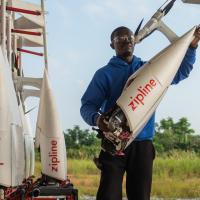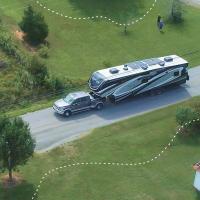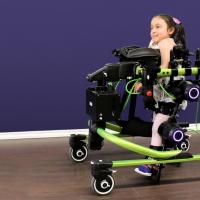Leon Burke Jr. lives hundreds of miles from his primary care physician. But despite her patient moving from Detroit to Florida, Burke’s doctor isn’t concerned.
“He’s had a lot of health challenges,” Dr. Stephenie Lucas, a primary care doctor based in Michigan, says. Among those challenges is high blood pressure, a condition which significantly increases the risk of disease in the heart, brain, kidneys, and other organs.
Most adults with high blood pressure are unaware of the problem coursing beneath their skin; high blood pressure is called “the silent killer” because it’s impacts on the internal organs have so few obvious symptoms. The WHO estimates that less than half of all adults with high blood pressure are even diagnosed, much less treated.
Burke is not only aware of his high blood pressure, he stays constantly on top of it, shooting his results to his doctor remotely.
He is using VitalSight by OMRON, a remote monitoring program to keep Lucas in the loop.
“I take my blood pressure, and I take my weight, and record everything,” Burke Jr. says.
Those blood pressure measurements, taken with an OMRON blood pressure monitor delivered to Burke Jr.’s home, are relayed to Lucas via a data hub also delivered as part of the VitalSight package. Burke Jr. knows his info is on the way when the blue light on his transmitter shines.
That information goes right to the patient’s doctor’s office — in this case Lucas — which is alerted immediately by the system if any of the numbers seem out of whack. With this steady stream of up-to-date information, doctors have a snapshot of their patient’s health they can use to help inform the best way to treat their high blood pressure.
“This is honestly the best I’ve seen him. And this is during the pandemic,” Lucas says. “He has really taken charge of his health.”
What is high blood pressure?
As the American Heart Association (AHA) explains, high blood pressure occurs when the force with which your blood is pumping up against the artery walls is too strong.
Unlike the blood pressure spike from exercise, chronic high blood pressure — also called hypertension — is long-term; it’s not the usual rise-and-fall that comes with different exertion throughout the day.
High blood pressure presents an extremely heavy health burden on the world — the World Health Organization estimates that it affects nearly 1.3 billion adults worldwide between the ages of 30 and 79.
The condition has earned its nickname “the silent killer” because it often does not present any symptoms until it is too late. Generally speaking, the only way to know if you have hypertension is to have your blood pressure taken.
“The idea of my patients not having a blood pressure check … is very scary.”
Keeping Tabs
Blood pressure is measured using a blood pressure monitor like the one the OMRON VitalSight service uses.
To figure out your blood pressure, the device inflates with air and measures two different pressures pushing against it: systolic and diastolic.
Modern blood pressure monitors do this automatically; in the old school method, these two pressures are what your doctor was listening for with their stethoscope. The systolic pressure is the larger number of the two, the one on top of your blood pressure reading, and occurs when your heart pumps, forcing the blood through your blood vessels. Diastolic pressure is the force of your blood while the heart is at rest.
Our blood vessels are elastic enough to handle the various pressures of blood flow they encounter — think how much harder your heart is pumping after running a mile. But as we age, the blood vessels lose elasticity.
Without their ability to expand as much, the same amount of blood volume is forced through smaller openings, increasing the pressure on the walls.
The Risks
Under the age of 65, men are more at risk of developing high blood pressure, according to the AHA (AHA), but, interestingly, that flips at 65+. But hypertension isn’t just a concern over 60. In late 2017, the AHA and American College of Cardiology revised their blood pressure categories, and reported that high blood pressure had tripled in men aged 22-44, and doubled in women under 45.
In the United States, African-Americans are more likely to develop high blood pressure, and have more serious cases. There are also blood pressure medications that are less effective in black patients.
While you can’t do much about those risk factors, the AHA does list a number of ways to mitigate your risk. This includes exercising, eating a balanced diet low in sodium, and avoiding excessive alcohol, tobacco, and stress.
It’s important to control those risk factors because untreated high blood pressure can lead to a myriad of complications. These can include heart attack and heart failure, strokes, aneurysms, kidney damage, and vision loss.
Hypertension can also increase your risk of diabetes, memory trouble, and certain types of dementia, the Mayo Clinic says.
Regularly monitoring your blood pressure to see if it’s too high is key to avoiding these major complications.
Unfortunately, because of its silent nature, the difficulties of accessing healthcare and, now, complicating factors like COVID-19, it can be harder for patients to keep tabs on their high blood pressure.
“The idea of my patients not having a blood pressure check for three to six months is very scary,” Lucas, the Detroit-based doctor, says.
Lucas’ practice was hit hard by the pandemic, and she needed a way to remotely monitor them to help ensure their condition didn’t get worse. (Hypertension is also a risk factor for severe COVID-19, according to the CDC.)
Inspired by OMRON’s mission to eliminate heart attacks and strokes, Lucas began putting her patients on the VitalSight program, receiving regular information from patients even as far afield as Florida.
Lucas began compiling clinical data to track how well VitalSight has been working. Thus far, she’s found that the regular monitoring has decreased the rate of both ER and office visits in her patients because results — like if their high blood pressure has taken a turn for the worst — are available to her immediately.
She found that VitalSight has helped patients like Leon Burke Jr. become more involved in their care, leading to better outcomes.
Using remote patient monitoring like VitalSight has allowed Lucas to extend herself as a doctor, she says, and apply a more rounded approach to patient care.
“With the VitalSight program, it’s not just about medication,” Lucas says. “It’s a much more holistic approach to the patient.”


